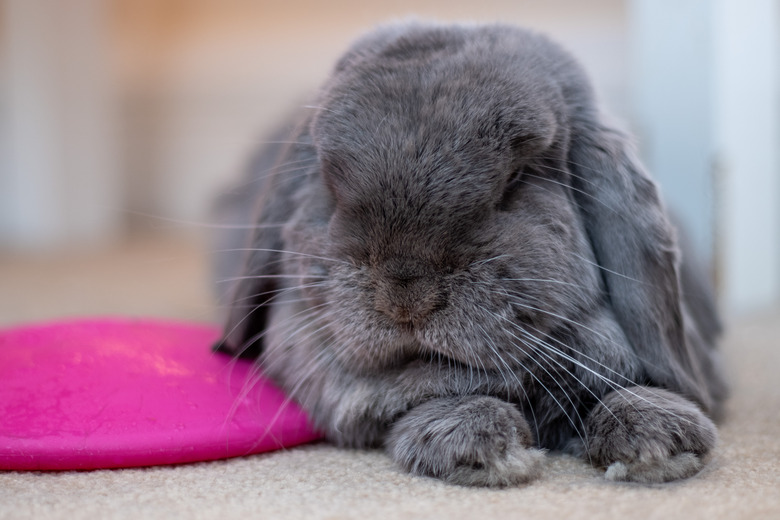How To Get A Rabbit To Drink Water
Rabbits have a complex digestive system, which requires them to have constant access to food, particularly high quality hay and water. Is it a concern if a rabbit doesn't drink water? Yes, a rabbit who stops eating or drinking or who does not drink enough can go into gastrointestinal stasis, or ileus, a life-threatening condition that can result in death in as little as 24 hours. Specifically, gastrointestinal stasis is a slowing of food passage through the GI tract.
However, you can encourage your rabbit to drink in several simple ways: keep the water bowl or sipper bottle very clean and provide leafy green vegetables. Rabbits generally drink more water from a bowl. However, whether you use a water bowl or a sipper bottle depends on your rabbit's preferences. You might want to offer both to increase the chances your rabbit gets enough to drink.
Rabbit water bowl
Rabbit water bowl
Some rabbits love to toss things, including their water bowl. Use a sturdy ceramic or metal crock bowl that your rabbit will have difficulty picking up. Avoid plastic as it can be tossed and chewed. Also, plastic breaks down over time slowly leaking into the water.
Metal is preferable if you have a ramp or second level in the rabbit hutch, because rabbits are prone to knocking a breakable ceramic dish from the second level. Check throughout the day to make sure your rabbit has plenty of clean water. Pull fallen strands of hay or other food out of the water to prevent mold — clean water is not only safer, but more appealing to rabbits.
Rabbit water bottle
Rabbit water bottle
If you offer a water bowl and still your rabbit isn't drinking, try a sipper bottle. These water bottles with drinking tubes attach to the side of the enclosure, keep water cleaner, and don't spill. Test the water bottle daily to ensure water freely flows from the sipper mechanism. Sometimes hay can become stuck in the mechanism, causing it to malfunction. A leaking water bottle signals the sipper mechanism is not working, or the seal around the cap is not tight.
Opt for a sipper bottle that has a metal, rather than a plastic, sipping mechanism. Rabbits have sharp teeth that can damage the plastic. Using a drinking tube with a ball bearing at the end, however, is not natural to most animals. Rabbits can learn to use a water bottle with coaxing. Smear a small bit of banana onto the sipper to encourage your rabbit to drink. Wipe the uneaten bits of banana off to avoid rotting. Once your rabbit uses the sipper bottle on his own, stop applying the banana.
Keep it clean and green
Keep it clean and green
Give your rabbit fresh water daily to encourage drinking. Wash your rabbit's drinking apparatus daily with hot water and a gentle detergent to prevent the growth of bacteria. Thoroughly rinse the detergent from the bowl or sipper bottle before filling with fresh water. Some of the reasons your rabbit doesn't drink water from either a water bottle or bowl might be that the water is the wrong temperature, it smells funny, or the container is unclean.
As a added bonus, provide your rabbit with fresh, leafy greens, such as romaine lettuce, each day to help with water intake. The general rule concerning how much to give a rabbit varies depending on the source, so consulting a vet is a good idea. One suggested guideline is for every 2 pounds your rabbit weighs, offer a minimum of 1 cup of fresh, leafy greens, but reduce the amount if your rabbit gets soft stools.
Consult a rabbit-savvy veterinarian
Consult a rabbit-savvy veterinarian
If your rabbit refuses to eat or to drink, which may indicate an illness or the start of ileus, consult a veterinarian immediately. A veterinarian may instruct you to give your rabbit water or unsweetened Pedialyte by syringe and will tell you how often and how much to give.
To give your rabbit water by syringe: First, gently put the syringe into your rabbit's mouth behind the incisors. Then slowly release the syringe, holding it sideways to prevent the water from going into your rabbit's trachea. Finally, allow your rabbit sufficient time to swallow the water or, if giving food, to chew then swallow. Never force feed water or food until a rabbit-savvy veterinarian has determined your rabbit is not suffering from an intestinal blockage.
